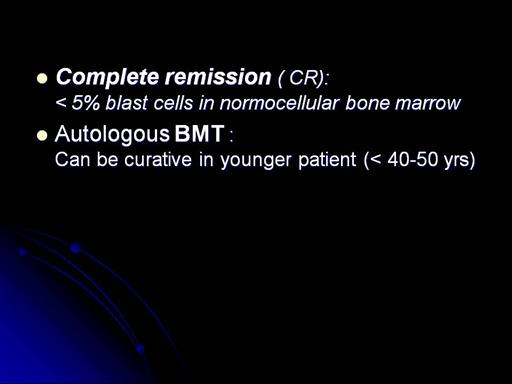| front |1 |2 |3 |4 |5 |6 |7 |8 |9 |10 |11 |12 |13 |14 |15 |16 |17 |18 |19 |20 |21 |22 |23 |24 |25 |26 |27 |28 |29 |30 |31 |32 |33 |34 |35 |36 |37 |38 |39 |40 |41 |42 |43 |44 |45 |46 |47 |48 |49 |50 |51 |52 |53 |54 |55 |56 |57 |58 |59 |60 |review |
 |
•The
treatment of childhood ALL, with the exception of B-cell ALL, has 5
components: induction, consolidation, interim maintenance, delayed
intensification, and maintenance. The goal of induction is to achieve
remission or <5% blasts in the bone marrow. Induction therapy generally
consists of 3-4 drugs, which may include a glucocorticoid, a
vincristine, an asparaginase, and possibly an anthracycline. This type
of therapy induces complete remission in more than 98% of patients.
•Consolidation
(ie, intensification) therapy is given soon after remission is achieved
to further reduce the leukemic cell burden before the emergence of drug
resistance and relapse in sanctuary sites (eg, testes, CNS). In this
phase of therapy, the drugs given at doses higher than those used during
induction, or the patient is given different drugs (eg, high-dose MTX
and 6-mercaptopurine (6-MP), epipodophyllotoxins with cytarabine, or
multiagent combination therapy). Consolidation therapy, first used
successfully to treat patients with high-risk disease, also appears to
improve the long-term survival of patients with standard-risk disease.
The addition of intensive reinduction therapy (administered soon after
remission is achieved) is similarly beneficial for patients in both risk
groups.
•In
interim maintenance, oral medications are administered to maintain
remission and allow the bone marrow to recover. This occurs for 4 weeks
and is followed by delayed intensification, which is aimed at treating
any remaining resistant leukemia cells.
•The
last phase of treatment is maintenance. This consists of LPs with
intrathecal MTX every 3 months, monthly vincristine, daily 6-MP, and
weekly MTX.
•Duration
of therapy:
•Whereas
B-cell ALL is treated with a 2- to 8-month course of intensive therapy,
achieving acceptable cure rates for patients with B-precursor and T-cell
ALL requires approximately 2-2.5 years of continuation therapy. Attempts
to reduce this time result in high relapse rates after therapy is
stopped.
•Most
contemporary protocols include a continuation phase based on weekly
parenterally administered MTX given with daily, orally administered 6-MP
interrupted by monthly pulses of vincristine and a glucocorticoid.
Although these pulses improve outcomes, they are associated with
avascular necrosis of the bone. Patients with high-risk ALL also may
benefit from intensified continuation therapy that includes the
rotational use of drug pairs.
|